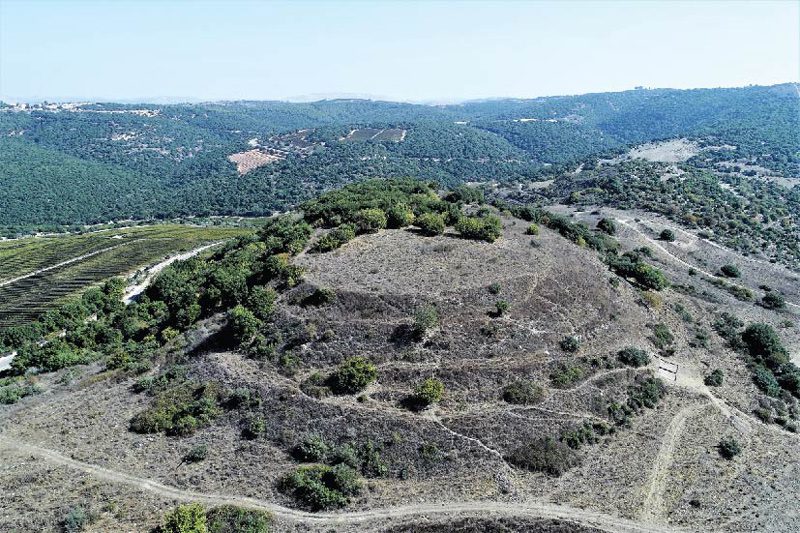Tel Rosh (Arabic: Khirbet Tell ‘er-Ruwesah) is a site in the western Upper Galilee, at c. 27 km. northeast of Acre. The core of the site is a pointy mound with an area of 25 dunams. To the east stretches the Meron ridge, whose peak reaches a height of over 1000 m. above sea level. The terrain there is unsuited for agriculture. To the west are the slopes of the western Galilee, featuring a perfect setting for intensive agriculture. The nearest water source is Ein Elkosh, some 500 m. from the mound. An ancient route connecting Acre and Tebnine (in modern-day Lebanon) is near the site. These geographical settings led to the flourishing of Tel Rosh, one of two settlements in Upper Galilee to have been continuously inhabited from the Early Bronze Age to the end of the Iron Age (The other one is Tel Qedesh).
History of Research
Tel Rosh was documented in the 19th century by scholars such as Victor Guérin and the Palestine Exploration Fund survey team. In the early 20th century, the site was “forgotten” due to the harsh terrain making it difficult to access. Between 1948 and 1953 the Israeli archaeologist Ruth Amiram “rediscovered” the site and conducted surveys together with Yohanan Aharoni. They collected pottery sherds from the Early Bronze Age to the Islamic period. In the years 2017-2018, an excavation was conducted under the supervision of Dr. Haya Katz from Kinneret College, in collaboration with the Open University. The excavations have shed further light on the history of the settlement.


Archaeological findings at Tel Rosh
The earliest evidence of human activity dates to the Early and Middle Bronze Ages. The material culture from these periods echoes Syrian traditions. Per the regional picture, during the Late Bronze Age, findings were scarcer. With that said, the discovery of two imported Cypriot juglets attests to the importance of the site during that period. The Late Bronze vessels were found under an Iron Age 1 structure, in which a “Tyrian” style clay oven was found. Pottery vessels characteristic of the Lebanese coast during the 11th-9th centuries BCE were found. Another structure dated to the Iron Age 2c (7th-6th centuries BCE) was also excavated. It contained vessels typical of Phoenician sites such as Tel Kabri, Tel Keisan, and Achzib, as well as pottery imported from Greece.
Apart from these, later pottery vessels were discovered, attesting to the existence of a settlement during the Persian, Hellenistic, Roman, Byzantine, Islamic, and up to the Ottoman period.
Identification of the site
Identifying sites in the Upper Galilee has proven difficult because the region is seldom mentioned in ancient sources. The earliest record of the name Ruwesah is from as late as the Crusader period – “Roeis”. This place appears as a possession of Castellum Regis, which was located in the modern village of Mi’ilya, c. 7 km. west of Tel Rosh.
According to the list of cities in the Book of Joshua, scholars of the last century suggested three places from the territories of Asher and Naftalie, to be identified in Tel Rosh.
“Beth-Anath” in the territory of Asher is mentioned numerous times in Late Bronze Egyptian royal inscriptions (such as Thutmose III, Seti I, and Ramesses II). This indicates it was an important place. It is also mentioned in the narrative of the Ptolemaic administrator Zenon (259 BCE), and the Onomasticon of Eusebius from the 4th century CE, who identified biblical Beth-Anath with a “Batanae”. Ruth Amiram and others proposed that Tel Rosh as “Beth-Anath”. However, this identification was challenged since Eusebius’ Batanae was supposed to be found 15 miles from the Banias (near Tel Dan), and therefore Beth-Anath was alternatively identified at the Lebanese village Safad el-Batikh.
“Beth-Shemesh” in the territory of Naftalie was proposed as the name of Tel Rosh by scholars such as Yohanan Aharoni. The reason is the appearance of Beth-Shemesh along with Yiron, which is identified with a Lebanese village carrying the same name, c.10 km. east of Tel Rosh. This identification was also challenged since all the places identified with the territory of Naftalie are located east of the Meron ridge and the drainage divide, while Tel Rosh is located west of it and therefore should be located at the territory of Asher.
“Rehob” appears twice in the territory of Asher. This led some scholars to assume it refers to two different places with that name, which was a common placename in the Ancient Near East. It was assumed there was a southern Rehob (often identified with Tel Bireh) and a northern Rehob. A place named “Rehob” appears in the list of cities subdued by Thutmose III. Haya Katz proposed that Tel Rosh is to be identified with Rehob since it is the only site in the region where there are both findings from the Late Bronze and Iron Ages. And yet, this identification is still uncertain.
Sources
Amiram, R. 1953. Khirbet tell er-Ruwiseh in the Upper Galilee. Eretz-Israel: Archaeological, Historical and Geographical Studies. 117-126. (Hebrew)
Katz, H. & Levin, Y. 2021. Tel Rosh: The Forgotten Rehob in the Upper Galilee. Palestine Exploration Quarterly 153. 24-41. https://doi.org/10.1080/00310328.2020.1751490
Biblical Hiking map

